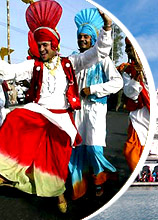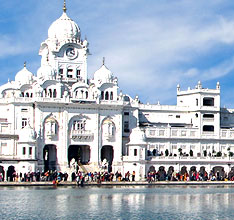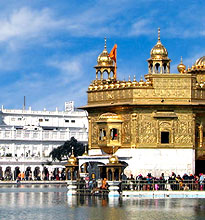 Sri Akal Takht Sahib is a famous pilgrimage place for the Sikhs in Amritsar. It is the central altar for Sikh political assembly. Akal Takht literally means the Eternal Throne and the place forms a part of the Golden Temple complex. It is situated on the other end of the causeway, connected to the Harmandir Sahib and faces the Darshani Deohri. Traditionally, all Sikh warriors sought blessings here, before going to battle. The place is a storehouse of various weapons used by Sikh Gurus and heroes. These weapons are ceremoniously displayed every evening, to the congregation of devotees.
Sri Akal Takht Sahib is a famous pilgrimage place for the Sikhs in Amritsar. It is the central altar for Sikh political assembly. Akal Takht literally means the Eternal Throne and the place forms a part of the Golden Temple complex. It is situated on the other end of the causeway, connected to the Harmandir Sahib and faces the Darshani Deohri. Traditionally, all Sikh warriors sought blessings here, before going to battle. The place is a storehouse of various weapons used by Sikh Gurus and heroes. These weapons are ceremoniously displayed every evening, to the congregation of devotees.History
Akal Takht was built during the Mughal rule. Emperor Jahangir had asked Guru Arjan Dev to pay a huge fine and revise the Adi Granth. When he denied to do so, the Guru was forced to sit on iron plates and many other tortures were inflicted on him simultaneously. He left for the heavenly abode on May 30, 1606, fighting for virtue. After this incident, a need was felt to defend righteousness, not with rosary alone, but also with weapons. Accordingly, Guru Hargobind Singh, the young son of Guru Arjan Dev, founded the Akal Takth by taking the dual swords of Miri and Piri.
Sri Akal Takht was founded in 1609. It is also called Akal Bunga, the house of the Lord. Guru Hargobind Ji himself used to sit here and hold a court of justice. Many Sikhs gathered there for redressal of their grievances. Akal Takht Sahib is a huge five storey building, standing on a marble paved platform. Baba Budha Ji and Bhai Gurdas raised this celestial fabric by their hand. In 1774, the construction of the ground floor was completed, whereas the other four floors were built by Maharaja Ranjit Singh. Famous Sikh General Han Singh Nalwa constructed the Golden dome.
In the Sikh system, God is referred to as the Sacha Patshah or the True King and his seat as the Sacha Takht or the True Throne. Akal Takht is the throne where the Guru sits and dispenses justice. While the Golden Temple stands for spiritual guidance (piri), Akal Takht symbolizes the dispensing of justice and temporal activity (miri). The Jathedar of Akal Takht issues Hukamnama (decrees), which is binding on every Sikh individual. Akal Takht has the right to punish somebody for bad deeds or showers praise on the deserving ones. It is respected above all individuals, even above the rulers.
On one occasion, Maharaja Ranjit Singh was penalized for his misdemeanors, by the Sarbat Khalsa at the Akal Takht. The Gursikh in Ranjit Singh solemnly accepted the punishment. However, corporal punishment to the sovereign was converted into a heavy fine. Sri Akal Takht is the nucleus of politics and religion, designated as miri-piri and bhagati-shakti. It has been shaping the religious, social and political aspects of the Sikhs. It is the symbol of the continuing faith in the unifying doctrine of the Sikh religion and its non-violent politics. It is the source which teaches that righteousness must be defended with rosary in one hand and sword in the other.












